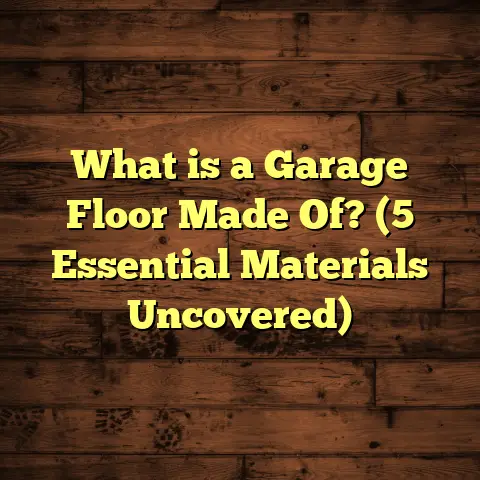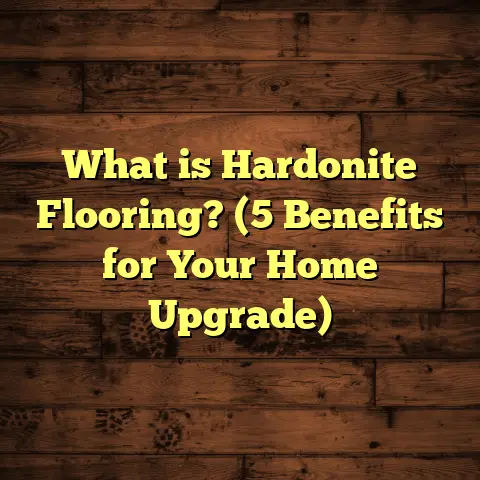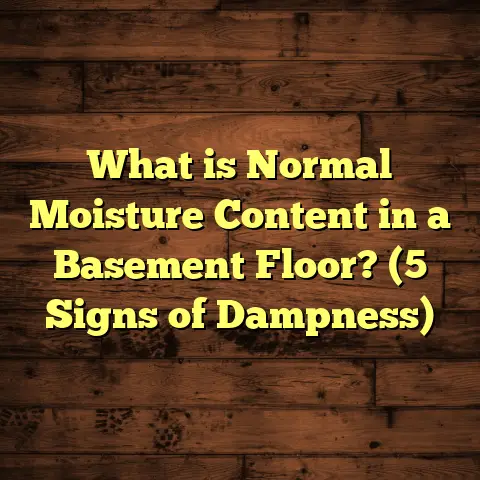What is Click Laminate Flooring? (5 Benefits You Didn’t Know)
According to the National Wood Flooring Association, over 40% of homeowners choose laminate flooring for their renovation projects. Over my 15+ years in the flooring industry, I’ve seen laminate evolve from a budget alternative to a favorite for style, durability, and ease. Among laminate options, click laminate flooring has become a standout due to its unique installation method and benefits.
You might have heard about click laminate but wondered: What exactly is it? Why are so many people picking it? And what hidden perks does it bring that aren’t obvious upfront? I’m here to share everything I’ve learned — from technical details and costs to my hands-on experiences in homes across the country. Let’s get into what click laminate flooring really is and five benefits you may not know about.
What is Click Laminate Flooring?
Click laminate flooring is a type of floating floor system, meaning it isn’t glued or nailed down but rather “floats” above the subfloor. The secret lies in its edges — each plank has a tongue-and-groove profile with a locking mechanism that snaps the planks together like puzzle pieces. This “click” system allows the floorboards to interlock securely without adhesives or nails.
Construction and Measurements
Each plank typically measures between 7 to 9 inches wide and 48 inches long on average. Thickness varies from 7mm to 12mm depending on quality and brand. Thicker planks (around 10-12mm) tend to feel sturdier underfoot and provide better sound insulation, which can be important in apartments or multi-level homes.
The core is usually made of high-density fiberboard (HDF) or medium-density fiberboard (MDF), engineered to resist moisture better than traditional wood. On top of this core is a photographic layer printed with realistic wood grain or stone textures. A melamine resin wear layer protects this surface, making it scratch-resistant and durable.
Why “Floating”?
Since the planks aren’t nailed down, the entire floor can expand and contract with temperature and humidity changes without buckling or warping. This floating nature also simplifies installation because you aren’t permanently fixing the planks to the subfloor.
In my experience, this system reduces installation time dramatically compared to glued or nailed floors — something I’ll get into more later.
Cost and Availability
Click laminate flooring is widely available in home improvement stores across the U.S., including Lowe’s, Home Depot, and local flooring retailers. Prices vary depending on brand, thickness, design complexity, and wear layer durability.
- Entry-level: $1.50 – $2.50 per square foot
- Mid-range: $2.50 – $4.00 per square foot
- Premium: $4.00 – $6.00+ per square foot
Installation by a professional typically adds $2 to $4 per square foot depending on location and project complexity. For example, in cities like New York or San Francisco, labor costs run higher than smaller towns.
Benefit #1: Installation Speed Saves Time and Money
One of the most remarkable things about click laminate flooring is how quickly it can be installed. Because each plank clicks into place without glue or nails, a skilled installer—or even a determined DIYer—can lay down substantial areas quickly.
My Experience Installing Click Laminate
I remember a project in Chicago where a client had just 72 hours before moving into a new condo. We had to replace old carpet with fresh flooring quickly. With a crew of two installers, we managed to install 1,000 square feet of click laminate flooring in less than two days.
Compare that with hardwood floors that require gluing or nailing plus drying time for finishes — often stretching over several days or even weeks for large projects.
Why It’s Faster
- No drying time
- No need for adhesives
- Fewer tools needed (just tapping blocks, spacers, and saws)
- Floating floor means no need for subfloor prep beyond basic leveling
The time savings translate into cost savings since labor can represent nearly half your total flooring budget.
Data to Back It Up
A study by the Flooring Contractors Association found that click laminate floors can be installed up to 40% faster than glue-down laminate floors and up to 60% faster than traditional hardwood installations.
Benefit #2: Perfect for DIYers – No Special Skills Needed
Ever thought about doing your own flooring but felt intimidated? Click laminate flooring might be your best bet if you want to try it yourself.
Why It’s User-Friendly
The locking mechanism means you don’t need to deal with messy adhesives or complicated nail guns. Basic tools like a saw (a miter saw or jigsaw works well), tapping block, spacers, and measuring tape are enough.
Story: My Cousin’s DIY Weekend
My cousin Mark was renting an apartment in Denver with outdated carpet and wanted a quick upgrade before his lease renewal. I gave him some starter tips and recommended click laminate flooring.
Within two days, he replaced his entire living room floor himself — even cutting around door frames and vents confidently after watching some YouTube tutorials.
What You Need to Know Before Starting
- Make sure your subfloor is clean, dry, and level (within 3/16 inch over 10 feet)
- Acclimate planks in room for at least 48 hours
- Leave expansion gaps along walls (usually 1/4 inch)
- Use underlayment for moisture barrier and soundproofing
The joy of seeing your own handiwork transform a space is hard to beat!
Benefit #3: Durability That Holds Up Over Time
When I first started working with laminate flooring over a decade ago, people worried about its durability compared to hardwood. The truth is that modern click laminate is tough stuff.
Abrasion Class Ratings You Should Know
Laminate floors are rated by AC (abrasion class) from AC1 to AC5:
- AC1: Minimal traffic (bedrooms)
- AC2: Moderate traffic (living rooms)
- AC3: Heavy residential traffic (kitchens, hallways)
- AC4: General commercial traffic (offices)
- AC5: Heavy commercial traffic (shops)
Most residential click laminates fall between AC3 and AC5 — meaning they resist scratches, dents, and stains better than many hardwoods in active households.
Real-Life Example
A family I worked with in Atlanta had two kids and two dogs running around daily. After three years on an AC4-rated click laminate floor, their surface still looked great — with only minor scuffs easily wiped away.
This wear layer thickness varies from 0.2 mm (basic) up to 0.7 mm on premium products. Thicker layers mean longer life spans.
Benefit #4: Moisture Resistance Expands Usage Options
While laminate floors are not fully waterproof like vinyl planks, many newer click laminates come with water-resistant cores and sealants that help prevent damage from spills or humidity.
Where It Works Well
Bathrooms are still tricky unless you’re using waterproof laminate variants. But kitchens, basements with moderate humidity control, mudrooms, or entryways are great spots for click laminate thanks to its improved resistance.
Case Study: Seattle Basement Installation
In Seattle’s damp climate, I installed water-resistant click laminate flooring in a basement rec room prone to mild moisture exposure. After three years with no signs of warping or swelling, the client was thrilled with how well it held up compared to their previous carpet that became moldy.
Benefit #5: Style Variety That Matches Any Décor
Gone are the days when laminate floors looked cheap or fake. Advances in printing technology combined with textured surfaces provide stunning realism.
Texture Options
- Embossed in Register (EIR): texture matches wood grain pattern
- Hand-scraped texture: mimics distressed wood feel
- Glossy or matte finishes
Designs Available
You can find virtually any wood species printed — oak, maple, walnut, hickory — plus exotic looks like bamboo or reclaimed barnwood styles. Some brands even offer stone-look laminates resembling slate or marble.
One recent client in New York chose a dark walnut laminate with hand-scraped texture that fooled their wood-loving friends into thinking it was solid hardwood.
How Click Laminate Compares to Other Flooring Types
Here’s a quick comparison based on my experience working with different floors:
| Flooring Type | Cost Per Sq Ft | Installation Time | Durability | Water Resistance | DIY Friendliness |
|---|---|---|---|---|---|
| Click Laminate | $2 – $6 | 1-2 days | High | Moderate | High |
| Hardwood (Solid) | $5 – $10 | 4-7 days | Very High | Low | Low |
| Engineered Wood | $4 – $8 | 2-3 days | High | Moderate | Medium |
| Vinyl Plank | $3 – $6 | 1-2 days | High | High | High |
| Ceramic Tile | $5 – $15 | 3-5 days | Very High | Very High | Medium |
Installation Tips from My Toolbox
If you decide to try installing click laminate yourself or want better results when working with contractors, here are some practical tips I’ve gathered:
Prepare Your Subfloor Thoroughly
Any unevenness greater than 3/16 inch per 10 feet can cause clicking issues or damage planks later. Use leveling compound if necessary.
Leave Expansion Gaps
Because laminate expands/contracts with temperature changes, leaving a gap of about 1/4 inch around all walls prevents buckling later on.
Use Quality Underlayment
Underlayment improves comfort underfoot and soundproofing while acting as a moisture barrier. For example:
- Foam underlayment: affordable and common
- Cork underlayment: better soundproofing but pricier
- Combination moisture barrier + soundproofing options exist as well
Cut Carefully
Always measure twice before cutting planks for edges or around door frames. A miter saw works well for straight cuts; jigsaws handle curves.
Common Problems & How I Fix Them
Even though click laminate is user-friendly, issues do come up occasionally:
Gapping Between Planks
Usually caused by improper acclimation before installation or insufficient expansion gaps at edges. Fix by removing affected rows and re-laying after adjusting gaps properly.
Creaking Floors
Often due to uneven subfloor or lack of proper underlayment beneath laminate. Solution: add suitable underlayment or level subfloor during installation.
Damaged Planks
If a plank gets scratched deeply or cracked:
- Remove damaged plank by unlocking surrounding boards carefully
- Replace with new plank from extra material kept during installation
Environmental Impact & Sustainability
I’ve noticed more manufacturers offering eco-friendly options:
- Using recycled wood fibers for core boards
- Low-VOC adhesives reducing indoor air pollution
- Certifications like FloorScore for healthy indoor air quality
Choosing these options helps reduce your project’s carbon footprint without sacrificing style or durability.
Budgeting Your Click Laminate Project
Here’s a detailed cost breakdown based on recent projects I’ve managed:
| Item | Cost Range | Notes |
|---|---|---|
| Materials | $1.50 – $6 per sq ft | Depends on quality & design |
| Underlayment | $0.25 – $0.75 per sq ft | Optional but recommended |
| Tools (if DIY) | $100 – $300 one-time | Saw rental/purchase + tapping kit |
| Professional Labor | $2 – $4 per sq ft | Includes prep & installation |
| Removal of Old Floor | $1 – $3 per sq ft | If applicable |
For example: Installing click laminate in a 1,000 sq ft living area could cost between $3,500 and $8,000 fully done by pros including materials and labor depending on quality choices.
Final Thoughts — Is It Worth It?
After years of installing all types of floors—hardwood, vinyl plank, tile, and carpet—I often recommend click laminate for folks who want style, durability, and easy installation without overspending. It’s especially good if you want to DIY or need fast project turnaround.
Have you thought about trying it? Or maybe you’ve already installed some? What was your experience like? If you want advice on picking brands or step-by-step help installing click laminate flooring yourself, just drop me a question!
If you want precise cost estimates tailored to your area, FloorTally is an online tool that helps calculate local material and labor costs so you can budget accurately before buying anything. I use it often when planning jobs because it saves time hunting down multiple quotes manually.
Thanks for spending some time chatting about click laminate flooring. Hopefully, you’ve learned some useful insights you didn’t know before. Feel free to reach out if you want help picking products, troubleshooting, or even just advice on design trends that match your home!





